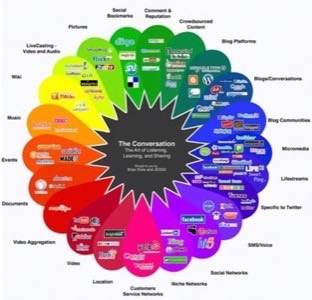Five years ago, “social” was the next great paradigm, and sure enough, today social is everywhere and everything is social. Facebook’s most recent announcements capitalize on this ubiquity and position the company as the hub of a system with an almost infinite number of spokes.

We are today with virtual personal assistants (VPAs) where Facebook was in 2004 – simultaneously on the verge of something very big, and yet only at the very beginning of a decades-long trajectory.
Guest author Norman Winarsky leads ventures, licensing, and strategic programs at SRI International, which includes the Commercialization Board and nVention – SRI’s partnership with the venture capital community that develops early-stage investment opportunities. Siri, which was spun out of SRI International, was recently acquired by Apple.

For more on SRI, read today’s post: “Consumer Info Overload – Meet the US Navy’s Relevance Technology! (New SRI Screenshots)
In 1975, almost 35 years ago, at the National Computer Conference, Danny Hillis made a prediction that soon there would be more microprocessors than people, drawing laughter from the audience. As Danny has recounted, audience members remarked to him afterwards: “Danny, what could you possibly do with them all?”
Virtual personal assistants can be seen through the same lens. It’s difficult to think today that I could and would entrust intelligent software agents enough to allow them to transact on my behalf in a variety of contexts and functions. But the vision is clear – as Siri’s CEO Dag Kittlaus said from the outset of that SRI venture:
“We believe that in the next five years almost everyone who lives a connected lifestyle will delegate the details of their everyday tasks to intelligent assistants to coordinate, execute and simplify the details of their life. I believe we will look back on these days and ask ourselves how we ever got by without our trusted assistant in the same way my kids ask in amazement about how I ever got by without laptops and the Internet.”
Today, artificial intelligence (AI) is still largely something we see in Hollywood movies more than we experience in daily life. But in the same way that “social” has matured and changed the world forever, so too will intelligence – it will become a constituent part of much of what we do and how we do it. We will expect, even demand, intelligence wherever we go, at the very point of the interface itself. Siri is the tip of the iceberg.
And we likely won’t have just one assistant – we’ll have two or three or maybe even 10, a scalable, distributed cadre, an army, even – of VPAs at our service. We will quite literally command the Web to rise up and proactively meet our needs, much like a concierge would – hospitable, knowledgeable, and very capable.
But to hearken back to Hillis so many years ago, what can we possibly do with them all?
The First VPA Distributed at Scale
Recently acquired by Apple, Siri’s success validates the idea of a “do engine” rather than a search engine – an AI cortex that manages a complex services ecosystem on the iPhone, a platform that has already exploded the idea of what it is to have a smart phone.
As assistants grow in popularity, they will become our primary UI for the web – as John Battelle has said, “The future of search is a conversation with someone you trust.”
Siri already uses some of the sites and services you know and love, things like OpenTable, Yelp and Rotten Tomatoes. But you may not be aware of TaxiMagic, TrueKnowledge or FlightStats.com where Siri introduces you to entirely new capabilities in the course of getting things done.
Assistants will leverage the best of the Web, not just to help you with the tasks you already have on your plate, but also to fundamentally extend your ability to get things done. They are digital prostheses that know what the Web can do for you (and who is good at doing what) and bring distributed intelligence to bear at the local level.
The vision of the assistant – indeed, many assistants – is possible today, an intricate orchestration of an array of sites and services on the fly, resulting in ultimate companionship for mobile lifestyles.
Hype and Reality
To the more jaded among you, this may sound nice, but unrealistic – perhaps even so far, unimportant. And you may be right. The AI dream has been long on promise and short on delivery.
Apple knows this better than anyone. Its Knowledge Navigator, a concept envisioned as early as 1987, was a gesture-based interface resembling the multitouch interface later used on the iPhone, and an equally powerful natural language understanding system, allowing the user to converse with the system via an animated butler.
Bill Gates himself saw the same value, remarking to a group of MIT students seven years later, in 2004: “If you invent a breakthrough in artificial intelligence, so machines can learn, that is worth 10 Microsofts.”
It is even rumored that Gates’ original vision for Longhorn/Vista focused on a concierge UI metaphor that adapted to user behavior over time.
AI as a marketing concept has a long and messy history – from Microsoft’s Clippy (and less famously, Ms. Dewey), straight through to IBM’s recent Watson project, and even AI wannabe’s like PageOnce, which is actually a great app but a “personal assistant” in name only.
This is all the result of a technology vision whose value proposition is so very clear (indeed, decades old) but has nonetheless seen little in terms of implementation.
So will we see other Siris? And how realistic is it to think of assistant-ness as a reliable, and moreover profitable, theme for new businesses in the years to come?
A Golden Age for R&D
Siri as some of you will know, was commercialized by SRI and born from SRI’s CALO project (Cognitive Assistant That Learn and Organizes) – a DARPA-funded initiative that saw some $200 million of investment over a five year period. Farecast (acquired by Microsoft), Radar Networks/Twine (acquired by Evri) and Adapx also have their roots in CALO.
This is serious technology. Evidence: Siri had 6 patents hanging on the wall on day one, and raised nearly $24 million in venture funding from SRI, Morgenthaler, Menlo, and Horizons Ventures to architect the system and eventually launch their service on the iPhone.
I remember sitting with our then entrepreneur-in-residence (who became a Siri co-founder and CEO) Dag Kittlaus and thinking about our idea of a do engine and how disruptive that concept could be. We were ebullient, but also humbled by the fact that CALO wasn’t nearly the beginning of our work in this area – it was only made possible by many earlier, pioneering efforts and many decades of foundational AI research at SRI.
The age of assistants will see a pendulum swing back to back-end engineering and serious R&D and long-term entrepreneurship. Every decade or so we see this kind of shift, a move to fundamentally upgrade the Web with focused, infrastructure-level innovation.
And with a strong set of venture exits and a demonstrable thirst for innovation that goes beyond so many opportunistic, trivial apps, the conditions are ripe.
Siri has proven that real VPAs are not only possible, they fill a need in the market (the company had 250,000 users within a month of launching).
Siri is a beginning, one that will spur further investment of time, money and brainpower. Be assured that developing virtual personal assistants is a capital-intensive undertaking. The potential reward is great – “10 Microsofts”, as it were. That’s a promise that will help further catalyze interest in AI from companies large and small.
SRI too will continue to spin out ventures from the CALO project and other SRI research projects consistent with this theme, starting with Chattertrap, currently in stealth but soon to emerge.
The Convergence of Many AI-Enabling Trends
Groundbreaking R&D, it should be emphasized, is never merely the product of a sizable chunk of money and a certain concentration of engineering talent.
Innovation processes are as much an indicator and guarantor of success as any other variable in the lifecycle. Indeed,when it comes to an expanse as wide as AI, reliable and replicable innovation processes really start to take center stage.
Breakthrough ventures, I can speak from experience, are the result of a disciplined innovation process for creating ventures to meet market needs, something that companies and innovation centers in the Valley and beyond should be reminded of from time to time; pushing out mere technology never works.
SRI is famous for things such as Doug Engelbart’s “Mother of All Demos” of interactive computing and the mouse – foundational breakthroughs that have stood the test of time. But what SRI does best is innovation. We combine research plus teaming plus venture creation plus commercialization to change the world. We address real needs with real technologies. Our secret sauce is, if anything, in our innovation processes, which help reduce the risk of our entrepreneurial activities.
Zooming out, it is fair to say that the state of the union of AI is quite healthy, and that Siri is indeed only the beginning. The revolution is not going to happen overnight, but the pace will start to accelerate from here.
We sit at the convergence of many AI-enabling trends – ubiquitous mobile access (increasingly, via smart phones), a programmable web of services with robust API access, a new paradigm of access and scalability in cloud computing, the maturation of the semantic Web and linked data, vast improvements in personalization, geo-awareness and now a demonstrable hunger by venture capitalists and giants like Apple in funding and acquiring new forms of intelligent software.
I’ll close by revealing a roadmap progression we put together at Siri in the early days that I hope you get a kick out of:
- Siri Beta: Periodically Human
- Siri 1.0: Practically Human
- Siri 2.0: Positively Human
- Siri 3.0: Who are you calling Human?
- Siri 4.0: Human, book me dinner and a movie.
The future is here, and it just got distributed pretty widely.










